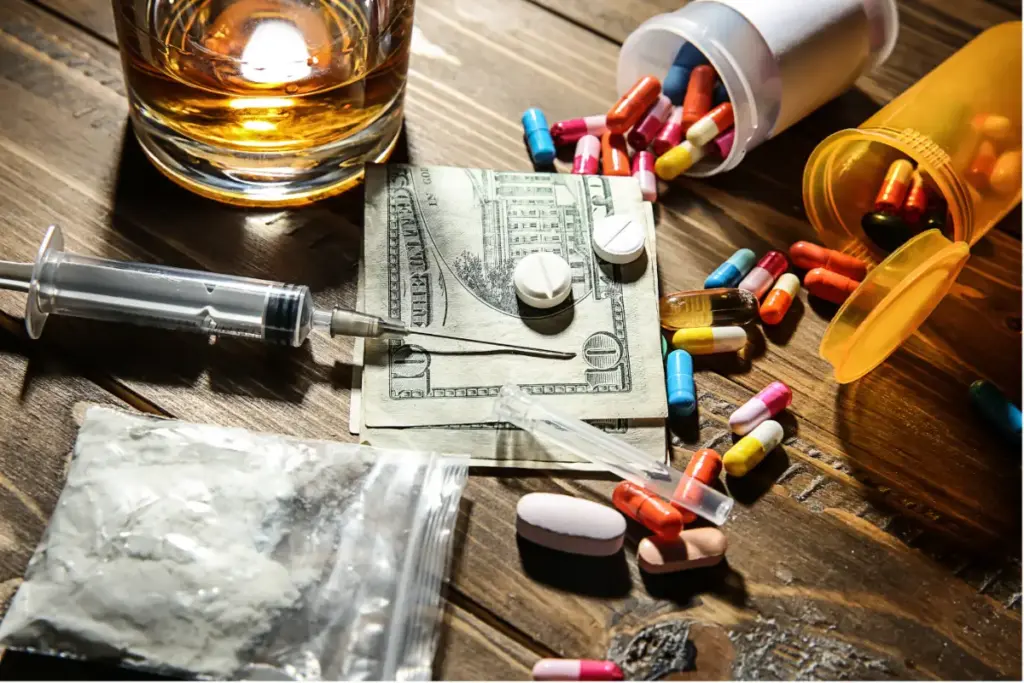
Substance abuse and dependence can lead individuals to develop such a high tolerance that they may find themselves needing to increase their dosage or introduce an additional substance to achieve the same desired effect.
Despite the dangers of mixing drugs, multiple drug use disorders have significantly increased over the years, with 30–49.7% of polydrug use among individuals with opioid use disorder or in 65% of patients receiving treatment. This scenario represents a significant public health problem, given the inherent challenges in treating a single substance abuse disorder in the first place.
Continue reading to understand the difference between polypharmacy and polysubstance abuse disorder, the risks of combining drugs, and how to seek medical assistance.
Table Of Contents:
What is Polysubstance Use?
Polydrug use is broadly defined as the intentional or unintentional consumption of more than one drug (illicit or legal) simultaneously or on separate occasions over a given period, causing overlapping effects in the individual, primarily for recreational, entheogenic, or off-label purposes.
Understanding these two scenarios can help healthcare professionals, researchers, and policymakers recognize polysubstance use patterns and develop targeted prevention and treatment strategies.
- Simultaneous use is the consumption of multiple drugs at the same time (alcohol + marijuana)
- Occasional use refers to drugs mixed at different times (cocaine one weekend, ecstasy the following month)
This scenario shouldn’t be confused with polypharmacy, which is the concurrent use of multiple medications under strict medical supervision to treat multimorbidity/chronic health conditions (i.e., hypertension, diabetes and depression)
However, polypharmacy also increases the risk of medication errors, adverse drug reactions, drug interactions and complications such as falls or cognitive impairment, especially among older adults.
Why Do People Mix Drugs?
Polydrug use occurs for a variety of reasons and the motivations can vary depending on individual factors. Here are some common reasons why people mix drugs:
Tolerance and Dependence
Chronic drug users may develop tolerance to the effects of a single substance, leading them to seek out new combinations or higher doses to achieve the desired effects.
Mixing drugs can be a way to overcome tolerance or enhance the euphoria experienced.
Enhanced Effects
People mix drugs to intensify or alter the effects of each substance, leading to a more potent high or different psychoactive experience.
For example, combining alcohol with stimulants like cocaine or ecstasy can boost euphoria or energy. Unintentional polysubstance use also occurs when someone unknowingly takes drugs mixed or contaminated with substances like fentanyl.
Experimentation
Research indicates that curiosity and the pursuit of novelty are the main drivers for the initial use of drugs. Novelty seeking is frequently reported as a prevalent emotion during relapse.
Young adults are the most vulnerable group for polydrug use as they spend considerable time in environment settings where drug use is encouraged. Among teen cannabis users, 27.5% reported additional drug use within the same year of starting cannabis use and nearly 67% used two or more other drugs.
Self-Medication
Individuals suffering from comorbidities such as mood and anxiety disorders tend to succumb to substance use disorders (SUD) and self‐medication to cope with the difficult symptoms and negative emotions associated with their disorders.
Over time, this substance abuse can develop into an independent SUD. Simultaneous use of alcohol and cannabis or alcohol and prescription opioids is one of the most common.
Availability and Accessibility
Chronic drug users usually chase the “high feeling,” and their drug abuse pattern depends on the availability and in accordance with the availability and price of different drugs.
As well individuals may mix drugs simply because they are readily available or because they are seeking a particular effect that can only be achieved through combining specific substances.
Common Polydrug Use Combinations and Health Risks
Healthcare professionals have already standardized some of the most common drug mixes outlined in the chart below.
However, combinations and health risks are not limited to those mentioned here. Numerous other potential complications depend on factors such as dosage, frequency of use, medical history and presence of other substances or medications.
The most common drug combinations are:
| Drug Combination | Drug Types | Health Risks |
|---|---|---|
| Alcohol + Benzodiazepines | Depressant | High risk of respiratory and central nervous system depression, slowed breathing and overdose. |
| Cocaine + Alcohol | Stimulant + Depressant | High heart rate and blood pressure, risk of heart attack, stroke or arrhythmias |
| Heroin + Cocaine (Speedball) | Opioid + Stimulant | Stimulation of cocaine masks the sedation of heroin, leading to higher doses of heroin, risk of respiratory depression and overdose. |
| Methamphetamine + MDMA | Stimulant + Stimulant | Both drugs increase body temperature and heart rate, dangerous levels of dehydration, overheating, and cardiovascular strain. |
| Opioids + Benzodiazepines | Opioid + Depressant | Both depress the central nervous system, slow breathing, loss of consciousness, and potentially fatal overdose. |
| Marijuana + Alcohol | Depressant + Depressant | Impaired cognitive and motor functions lead to decreased coordination and judgment and an increased risk of accidents. |
| LSD + MDMA | Hallucinogen + Stimulant | Increased serotonin levels in the brain, leading to serotonin syndrome (agitation, hallucinations, seizures, and high body temperature) |
| Prescription Opioids + Sleeping Pills | Opioid + Depressant | Both depress the central nervous system, leading to slowed breathing, loss of consciousness, and potentially fatal overdose. |
Alcohol use disorders appear in almost every polydrug use combination, most probably due to its widespread availability and social acceptance. This trend underscores the significant role alcohol plays in polysubstance use, contributing to the complexity and associated health risks.
Polydrug Use Treatment Options
Polydrug treatment must require integrated, personalized interventions to address the complications of substance use involving multiple drugs.
Integrated treatment may involve several components:
- Assessment and evaluation to understand substance use, medical history, mental health status
- Drug detox to safely manage withdrawal symptoms and stabilize health condition
- Psychotherapy to address underlying issues contributing to polydrug use (CBT, DBT)
- Medication-assisted treatment to manage withdrawal symptoms (methadone, buprenorphine, naltrexone)
- Support and peer groups for encouragement during the recovery process (NA, AA)
- Medical and psychiatric care to address dual diagnosis that contribute to substance use disorders
- Aftercare planning for relapse prevention, continued therapy, housing assistance
Polydrug Use − Overdose Risks and Key Takeaways
The high rates of polysubstance use, particularly among teens and young adults, underline the need for updated approaches to address complex drug interactions.
As in 2019, nearly 50% of drug overdose deaths involved multiple drugs, researchers, clinicians, policymakers and the community should work together to address the multilayered nature of substance-related health epidemics and establish practical prevention practices. There is no safe way to use drugs except medication under strict medical supervision.
In cases of suspected overdose, call 911 and keep the person awake and breathing. Do not induce vomiting and stay close until emergency assistance arrives.
People Also Ask
What is the definition of a polydrug?
A polydrug refers to a substance that contains two or more drugs or active ingredients, either combined intentionally or inadvertently, often resulting in complex interactions and effects.
What is the definition of a polysubstance?
Polysubstance abuse meaning refers to the simultaneous misuse or dependence on multiple substances, often including drugs and/or alcohol. This pattern of substance use can complicate diagnosis, treatment, and recovery, as it poses unique challenges compared to single-substance abuse.
What are some polysubstance abuse examples?
Examples of polysubstance use include combining alcohol with benzodiazepines, using heroin along with cocaine, or mixing prescription opioids with sleeping pills, often leading to heightened risks and complexities in substance use.
What are 3 examples of common drugs?
Three examples of common drugs include caffeine (found in coffee and tea), acetaminophen (found in pain relievers like Tylenol), and ibuprofen (found in anti-inflammatory medications like Advil).
Hope Without Commitment
Find the best treatment options. Call our free and confidential helpline
Most private insurances accepted
Find Drug Rehabilitation Centers Near You Anywhere In the US
Addiction Resource team has compiled an extensive list of the top drug rehabilitation facilities around the country. Use our locator tool to find the best centers near you.
Page Sources
- Bonfiglio, N. S., Portoghese, I., Renati, R., Mascia, M. L., & Penna, M. P. (2022). Polysubstance Use Patterns among Outpatients Undergoing Substance Use Disorder Treatment: A Latent Class Analysis. International Journal of Environmental Research and Public Health, 19(24). https://doi.org/10.3390/ijerph192416759
- Varghese, D., Ishida, C., & Koya, H. H. (2023, August 28). Polypharmacy. StatPearls - NCBI Bookshelf. https://www.ncbi.nlm.nih.gov/books/NBK532953/
- Boileau-Falardeau, M., Contreras, G., Garipy, G., & Laprise, C. (2022). Patterns and motivations of polysubstance use: A rapid review of the qualitative evidence. Health Promotion and Chronic Disease Prevention in Canada : Research, Policy and Practice, 42(2), 47-59. https://doi.org/10.24095/hpcdp.42.2.01
- Wingo, T., Nesil, T., Choi, S., & Li, M. D. (2016). Novelty Seeking and Drug Addiction in Humans and Animals: From Behavior to Molecules. Journal of Neuroimmune Pharmacology : The Official Journal of the Society on NeuroImmune Pharmacology, 11(3), 456. https://doi.org/10.1007/s11481-015-9636-7
- Crummy, E. A., Baskin, B. M., & Ferguson, S. M. (2020). One Is Not Enough: Understanding and Modeling Polysubstance Use. Frontiers in Neuroscience, 14. https://doi.org/10.3389/fnins.2020.00569
- Kataja, K., Tigerstedt, C., & Hakkarainen, P. (2018). More social research into polydrug use. Nordisk Alkohol- & Narkotikatidskrift : NAT, 35(6), 399-403. https://doi.org/10.1177/1455072518807055
- Polysubstance use facts. (n.d.). https://www.cdc.gov/stopoverdose/polysubstance-use/index.html


 Reviewed by:
Reviewed by:  Written by:
Written by: 

 FindTreatment.gov
FindTreatment.gov